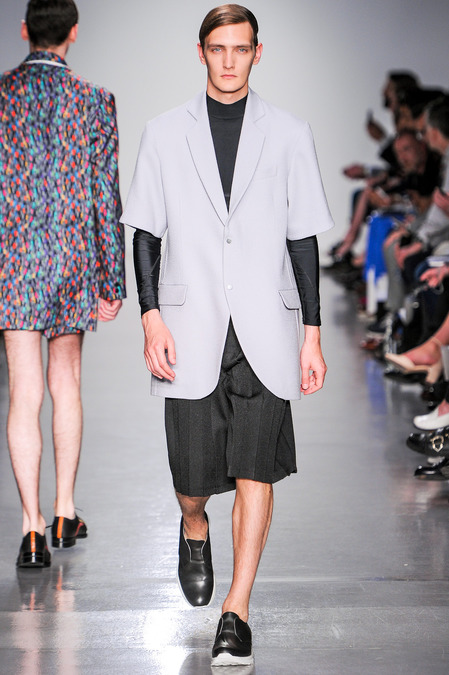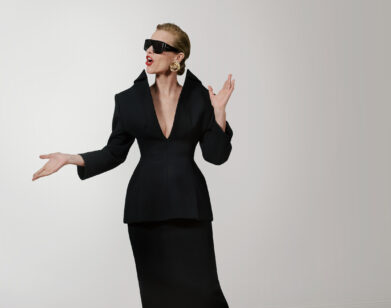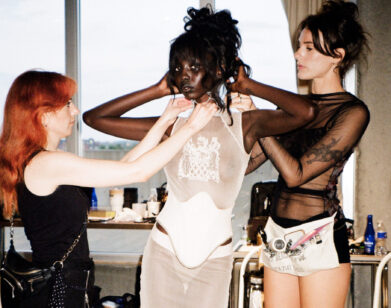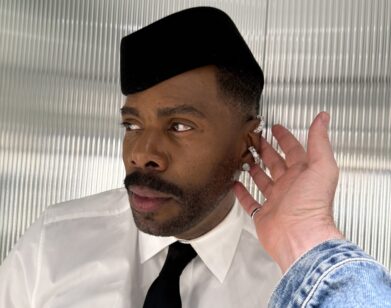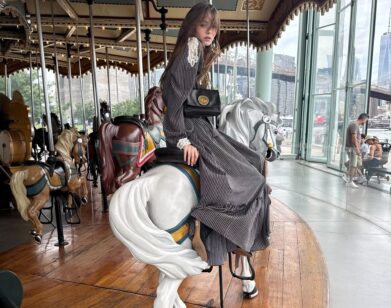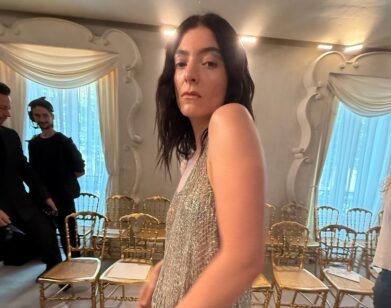Menswear Monday: Agi & Sam
Prints, in all their noisy glory, have been one of the biggest stories in menswear and womenswear for several seasons. If you were Agape Mdumulla and Sam Cotton, the London duo behind Agi & Sam who count print at the core of their brand, you might start to worry at when the trend might end. But Mdumulla isn’t nervous. “Obviously it’s big right now, but it’s just a style of print,” he explains. “It’s very digital. It’s quite brash and abrasive.” And while he and Cotton proved early on that they had an eye for that style, their last collection showed how much else they could do with their technique of choice. Tonal screen-printing, for example, was more or less invisible, but created texture on shirts and suits. Some patterns were so microscopically busy as to look like they were woven of multi-colored threads.
The designers are both 27, young and comfortable with the pace of change that the Internet has set in place. “Some random guy in a band in the middle of America can put a picture up and suddenly it’s a trend in, like, Tokyo,” Mdumulla offers.
Having moved to London only five years ago, their success has been just as sudden. After meeting as interns at Alexander McQueen, the two decided if they were going to work for free, they’d rather work for themselves. Following the quiet fashion week debut of their first collection in 2010, their colorful lookbook went verifiably viral online. Fashion East, an English non-profit meant to support young design talent, sponsored their next show, and shortly thereafter their line was picked up by Topman’s MAN show for three consecutive seasons. Backstage at their second showing, Topman creative director Gordon Richardson invited them to design a capsule collection, which went on sale this summer—just before their first solo show in some time.
Like good 20-somethings, Mdumulla and Cotton are staying busy, over-stimulated, and amply inspired. When we phoned the former on a workday last week, he had his mind on ancient history, the ’90s, and the near future.
NAME: Agape Mdumulla
HOMETOWN: York, United Kingdom
SHOWING IN: London
ORIGIN STORY: We were both sort of at a weird stage where we were trying to get jobs but we’d both graduated in the middle of the recession in 2008. It hit pretty hard. We were just talking through ideas about what was happening and what was available to us. They were all junior positions, but the jobs weren’t really that creative, whether it was in supply chain or something. If we got jobs, it would’ve been just boring work or whatever. Then we’d get put forward for higher positions or midway positions, but we didn’t really have the experience because we’d only been interns. So we just put our heads together and we just thought, We might as well do this together. Because we come from different disciplines—I studied fashion design and Sam studied illustration—we thought it’d work out quite well and we’d hit a nice balance.
BEGINNERS’ LUCK: [laughs] To be honest, I think there was a bit of naïveté that came into play. We didn’t think about the idea of starting a business. It was kind of like I made a collection with a couple of people that had helped me. The whole idea of having a business, trademarking, IP, accountants, billing, factories, production—they didn’t even come into it. But I think that helped, because I think had we known what we know now, we probably would have thought twice about going into it. Obviously we feel so lucky to be in the position we’re in, but we probably would have sought a lot more help and a lot more advice, and tried to make more.
THE DIVISION OF LABOR: I guess that’s changed as we developed. In the beginning, we’d come up with a concept together and discuss it and write all that out, and discuss what kind of garments we wanted to make. We’d research together as well, so we’d look at shapes and colors and fabrics, et cetera, and say, “Oh, it’d be cool to do a jacket like this,” or, “It’d be cool to do a print like this.” And then we’d separate and I would go ahead and actually design the pieces and I would make them, do the pattern cut and sew them up, and Sam would go away and actually do the print, and it’s almost like we would be each other’s stylists. Sam was a design stylist and I was like a print stylist. He’d be like, “Oh, maybe we should change that,” and I’d do that on the print side. But as the business has developed, that’s kind of merged a bit more. Sam has started to sketch more and come up with more solid design ideas. And in terms of prints and technique and stuff, I’m able to create more solid ideas and mess around on Photoshop and contribute in that way.
THE DIFFUSION DILEMMA: With the Topman thing, we wanted to base it around an imaginary football team in the early ’90s. And the reason we wanted to do that is because interest in football and this whole sportswear thing seems to be such a big thing, and then we made a team called The Owls. The way that we approached this is, we’re thinking that by doing something like that, it’s something that would appeal to a normal guy that maybe isn’t that fashion-y, but it would also appeal to the fashion community. But in terms of our design process, when we went in for our first meeting with Topman, and Sam and I had thought about trying to make it a bit more commercial, we went in and they were like, “No, don’t do that.” They actually encouraged us to be a bit braver with it and a little more out there, which was good, because I think people definitely responded really well to all the prints. It’s quite nice, because I think it definitely showed that people actually do wanna wear that. It just needs to be at a good price for them.
THE FUTURE OF MENSWEAR: It’s such a difficult question. It doesn’t happen the same way that it did 10 years ago where there’s obvious trends. There’s so much out there and the market is so saturated. Obviously there’s this whole luxe streetwear trend, and I think as long as Givenchy does that it’ll probably continue, and that has been an influence. I think in terms of music, hip-hop has been the biggest thing at the moment. Nothing else really comes close. So I think as long as that happens, and as long as Givenchy keep on doing what they do, streetwear will continue to just dominate.
SKATESPIRATION: I think skating has influenced me a lot recently. I used to skate a lot when I was a kid, and I haven’t for years. Maybe it’s got something to do with the trend, this resurgence in skate brands. It does kind of feel like skateboarding is one of the only things that’s happening in terms of subculture right now and it’s carrying over into fashion. I’ve been watching old skate videos and looking at skate brands and how they operate. It’s quite annoying, because I’m definitely a product of this mass globalization, post-modernistic thought world we live in where everything is at the touch of a button, but I’ve always kind of been like that, so my style has always shifted. I’ve always taken a lot of things from a lot of different places and put that together. That’s not to say that I wanna go ahead and do a skate brand, but I’m just looking at what it is that makes it a skate brand and the whole lifestyle. And I find that quite inspiring, the whole camaraderie, skating with your friends, and what you wear to do that and why, and all the music involved. It’s quite a nice thing.
Menswear Monday runs every other Monday. For more, click here.

